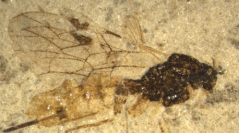

 Geodiversitas
44 (23) - Pages 645-664
Geodiversitas
44 (23) - Pages 645-664With an estimated 100 000 extant species, Darwin wasps (Ichneumonidae) are more specious than all vertebrates together. However, only 288 fossil species have been described to date, with hundreds more awaiting formal description in palaeontological collections. One of the largest gaps in our knowledge concerns the c. 12 million years between the K-PG mass extinction and the late Ypresian, from which only two species have been formally described, including Pimpla stigmatica Henriksen, 1922 from the Danish Fur Formation (c. 55 Ma). I here redescribe and reclassify this species in the genus Epitheronia Gupta, 1962 and describe nine new species from this fossil locality that are consistent with a placement in Pimplinae: Crusopimpla collina n. sp., C. elongata n. sp., C. minuta n. sp., C. rettigi n. sp., C. violina n. sp., Theronia? furensis n. sp., T. nigriscutum n. sp., Xanthopimpla ciboisae n. sp., and X. crescendae n. sp. The diagnosis of the genus Crusopimpla Kopylov, Spasojevic & Klopfstein, 2018 is amend in the light of the new species. By comparing the preserved colouration between and within specimens of different species, we draw conclusions about the taxonomic usefulness of colour patterns observed in Fur Formation ichneumonids. The number of described species of pimpline parasitoid wasps from Fur is very high when compared to any other fossil deposit, but low with respect to numbers of extant species. Further study and excavation of Fur ichneumonids will certainly reveal an even higher diversity.
Pimplinae, Denmark, colour preservation, Darwin wasps, parasitoid wasp, species delimitation, species richness, new combination, new species